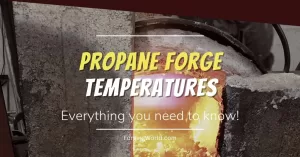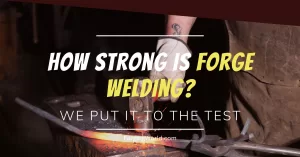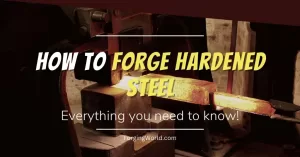Rebar is notorious for being mystery steel because we don’t know what it is made of. From my experience with forging rebar, I have realized that is not consistent material to work with. From my previous articles about rebar, you could learn that the rebar can be forged for various purposes. However, I never mentioned the possibility of forge-welding rebar. This is what this article is all about.
So, can you forge weld rebar?
It is possible to forge weld rebar, however, the results may not be consistent. Note that the composition of the rebar varies extremely, therefore, sometimes you will get a nice weld, and sometimes you won’t. Rebar can also be forge-welded to other alloys, such as spring steel.
Ok, that would be a direct and short answer, but what about other unanswered questions? Does forge-welded rebar break easily? Is flux required to forge weld rebar? Does forge-welded rebar hold an edge well or not?
These are only some of the questions that will be answered, so make sure to check the rest of the article.
Blacksmiths, let’s start.
How Good Is the Weld?
As we already mentioned, rebar is very inconsistent due to the unknown composition. In the vast majority of cases, you don’t know what you are dealing with. With a piece of rebar, you don’t know whether you can harden it or not.
You don’t find out until you do it. The same thing is with forge welding. From both my and many other blacksmith’s experiences, it is typically known that you can forge weld rebar. However, the quality of those welds varies from person to person. Some of the crucial factors include:
- Experience
- Fuel
- The number of heat
- Weld timing
Experience is the primary factor that will influence how good your weld is going to be. If this is your first-time forge welding, don’t expect to make a perfect weld. Especially if your first attempt is to forge weld rebar. On the other hand, if you already did some forge welding, expect to make a good weld. Keep in mind that some rebar bars won’t be able to forge weld, no matter how good you are.
Fuel is another very important factor that will determine the quality of your weld. Both coal and gas can be used to forge weld rebar, however, each requires a different approach. If you are a beginner, forging with coal may seem more complicated due to the fire maintenance. I would recommend using a gas forge if you are not familiar with solid fuel forge. A gas forge is much simpler to use. There is a myth about propane forge not being able to reach forge welding temperatures. While that may be back in the day, modern propane forges can reach such temperatures without a problem.
The number of heat also impacts the weld quality. This one also depends on the size of the stock but generally, you should do at least 2-3 heats. One is too little. Recently I did a comparison of forge welding with different numbers of heat. With one heat, the rebar snapped easily. With two heats, it snapped with some elbow grease. But with three heats, it didn’t snap at all.
Weld timing is referred to the time you take out the material from the forge and start hammering. I see a lot of people saying that sparking is the best way of knowing that. While sparking is a good sign when forge welding in a coal forge, it is not when using a gas forge. This is mainly due to different oxygen availability.
With a propane forge, you are looking for the right color (bright yellow), not the sparks. Finally, I would add that the distance between the forge and the anvil should be close as possible so you can start striking quicker.
If you are wondering why I didn’t mention flux, don’t worry, keep reading.
Do You Need Flux to Forge Weld Rebar?
Before I answer the potential requirement of flux, I must first explain what the flux is in the first place. The role of the flux is to reduce the temperature at which impurities and scale become fluid on the surface of the material. It basically protects the surface from erosion. In case you don’t use flux, you must raise the temperature so you can make the surface elements fluid.
You don’t necessarily need flux to forge weld rebar, however, it will make the process much easier. With propane forge, chances are you will need flux, due to the internal atmosphere. If you don’t have much experience with forge welding, you should use flux. Borax is generally the best choice.
Note that the vast majority of the time, you will need to use flux, unless you are one of the welding masters. So, in theory, yes, it is possible to forge weld without flux. In practice, not really. Fundamental requirements for forge welding are more important than the flux. No matter how much flux you use, if the steel is not cleaned you won’t get a good weld. Not using flux also increases the chances of developing a small film on the reactive surface.
Borax is historically the most consistent and reliable flux used for forge welding. It is also very cheap and readily available. You can also mix with other additives to produce a better effect.
Does Forge Welded Rebar Hold an Edge Well?
In one of my previous articles, I discussed whether the rebar can be hardened. In that article, I pointed out that almost every rebar can be hardened. The only question is by how much. If you have 3 different rebar bars, try to test each one of them in terms of hardenability. Chances are, hardness will vary on each.
One day I was making knives out of the same rebar bar. The first one held the edge decently. The second one broke like glass when I dropped it while the other 3 almost didn’t harden at all. With rebar, you never know what to expect because carbon content will be different even throughout the same bar. Both water and oil can be used for quenching. There is no general rule for which one is superior.
If you are planning to make a knife out of rebar, I recommend making a sparking test which is commonly used for identifying scrap metal. The sparking test is a fast and convenient test that doesn’t require any special equipment. Some type of grinder is all you need, preferably a bench grinder due to better control. The key thing is to observe the volume, length, and color of the sparks. If the rebar produces a lot of sparks, it may be worth making the blade out of it.



